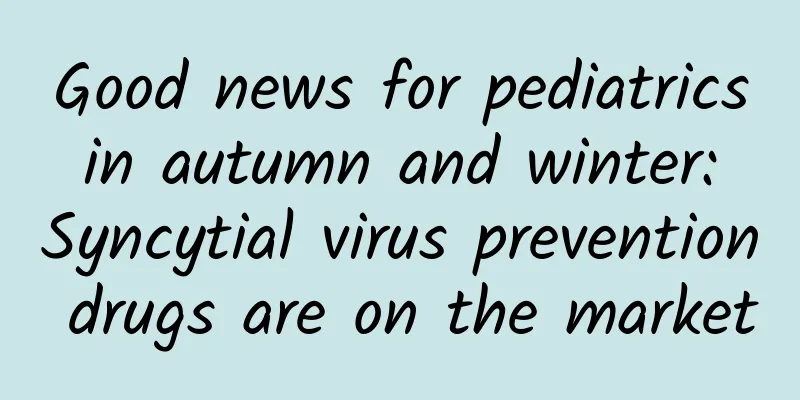Good news for pediatrics in autumn and winter: Syncytial virus prevention drugs are on the market

|
This is the 5168th article of Da Yi Xiao Hu Autumn and winter are the peak seasons for respiratory infectious diseases, including influenza, epidemic meningitis, mumps, hand, foot and mouth disease, and new coronavirus infection. In recent years, the incidence of mycoplasma, respiratory syncytial virus, and adenovirus among adolescents and children is relatively high. In particular, respiratory syncytial virus will enter the epidemic period from October every year. Syncytial virus is a common and highly contagious respiratory virus. It is the primary pathogen detected in infants under 1 year old who are hospitalized for lung infection. Infants with severe syncytial virus infection may have impaired lung function such as repeated wheezing or asthma, which will have long-term effects on children. Syncytial virus is an RNA virus that is transmitted through droplets and close contact, or through contaminated hands and surfaces. Patients often experience upper respiratory tract symptoms after infection. The incubation period of syncytial virus is usually 2 to 8 days, and excretion of toxins from the body can last for 1 to 3 weeks. Most early infections are confined to the upper respiratory tract, manifested by upper respiratory tract symptoms such as nasal congestion, runny nose, cough and hoarseness. The typical symptoms of adults after infection are very similar to the common cold, such as low fever, cough, nasal congestion, and runny nose. Most patients' symptoms will disappear on their own within 1 to 2 weeks. Moderate and severe cases have more obvious dyspnea, wheezing, cyanosis of the lips and mouth, nasal fan and three-depression signs, and a few severe cases may also be complicated by heart failure. Since maternal antibodies cannot completely prevent infection, syncytial virus pneumonia can occur at any time after birth. It is more common in children under 3 years old, and more severe cases can be seen in 1 to 6 months. It is more common in winter and spring in northern my country, and more common in spring and summer in Guangdong. Since antibodies cannot completely prevent infection, reinfection with syncytial virus is extremely common. Some people have observed that the incidence of reinfection is as high as 65% in 10 years. Syncytial virus is highly contagious. There are reports of family members being infected one after another. When it occurs within the family, older children and adults generally have upper respiratory tract infections. Syncytial virus may cause severe coughing and persistent wheezing in young children. In severe cases, there is a risk of respiratory failure. It is also a relatively dangerous virus for children. Since the autumn of 2004, it has been marketed in Europe and the United States. Literature has reported that this innovative prevention method can effectively reduce the risk of hospitalization of infants due to lower respiratory tract infections caused by syncytial virus by 82%. The efficacy is very high. my country's first vaccine to prevent lower respiratory tract infections caused by syncytial virus, the long-acting monoclonal antibody Nissvir monoclonal antibody injection (Leweichu), only needs a single injection to provide timely, rapid and direct protection for newborns and infants who are about to enter or are born in the first respiratory syncytial virus infection season, thereby preventing lower respiratory tract infections caused by syncytial virus. For newborns or infants under 1 year old who are about to enter or are born in the first syncytial virus infection season: the recommended dose for infants weighing less than 5kg is a single intramuscular injection of 50mg; the recommended dose for infants weighing greater than or equal to 5kg is a single intramuscular injection of 100mg. Starting from September 26, 2024, the public can search for the RSV prevention appointment applet through WeChat "Search" to learn about the detailed appointment map. Some hospitals have begun to carry out vaccination work in accordance with "informed consent, voluntary self-payment, local management, and orderly advancement". The first batch of pilot users in Shanghai are 7 vaccination clinics set up in municipal obstetric specialist medical institutions and municipal children's specialist medical institutions. The other 4 are Shanghai Children's Hospital, Xinhua Hospital Affiliated to Shanghai Jiaotong University School of Medicine, China Welfare Institute International Peace Maternity and Child Health Hospital, and Shanghai First Maternity and Infant Health Hospital. Author: Putuo District Central Hospital Department of Respiratory Medicine Shi Zhaowen, deputy chief physician |
Recommend
IAS: 2021 Tweet Trends and Information Stream Advertising Research Report
The latest research released by Integral Ad Scien...
Streamlabs: YouTube Live viewership reached 24% in Q1 2019
Streamlabs and Newzoo released data for the first...
Psychological adjustment of pregnant women after childbirth
Many pregnant women will experience a certain deg...
What are the symptoms of dysmenorrhea? 5 foods that can relieve menstrual cramps
Dysmenorrhea is a common physiological disease am...
How much does Xu Jin Huan's popular ice cream cost? What flavor does Xu Jin Huan's ice cream taste like?
NOC Xu Jin Huan is a popular ice cream brand laun...
What are the best nutritional supplements for each stage of pregnancy?
For the health of pregnant mothers and the develo...
What causes cervical effusion?
Having some fluid accumulation in the uterine cav...
What is the reason for the menstrual period to be light and not clean?
Menstruation is a woman’s “best friend”, accompan...
How to recover after hip replacement?
After hip replacement surgery, recovery is critic...
Is it possible to ovulate before menstruation?
What you should actually be concerned about is wh...
What are the symptoms of postpartum heel pain?
Postpartum women are prone to heel pain due to po...
It's the fourth day of medical abortion and I still feel my menstrual period is heavy
After a medical abortion, the body is damaged and...
How to sprint one month before the high school entrance examination? How to improve mathematics one month before the high school entrance examination
With the development of society, people are incre...
What can I eat during confinement?
Everyone knows that pregnant women need to stay i...









